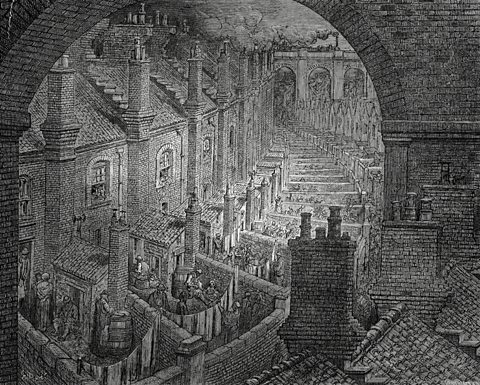The pressures of industrialisation and urbanisation

Between 1750 and 1900 the population of England and Wales rose dramatically, from about 7 million to over 40 million.
Existing towns and cities swelled in size and new places like Manchester and Merthyr Tydfil developed. There were also changes in rural areas too, with new machinery and techniques changing rural workers' lives.
Causes of urban crime
Urban areas were overcrowded and full of disease. There was little planning, and no infrastructure or amenities. People often lived in back-to-back houses, with open sewers, and rubbish-strewn streets. Crimes were more common in urban areas.
- Many lived in rookeryA slum area in a town or a city where rates of poverty and crime were high. where crime was the norm. There were different types of criminals, for example those who stole pocket watches from their chains were referred to as thimle-screwers.
- It was easy for a criminal to evade capture through the narrow, winding streets, alleyways and courts.
- It was easy for people to remain anonymous in a city. In pre-industrial villages, people had known each other, but in these new towns people did not. It was easier to get away with crime.
- Policing was ineffective.
- Poverty and poor living conditions led to many people resorting to crime to improve their lives. Many people were dissatisfied with their lives and wanted more money.
- Industrial accidents were common. There was no compensation, and a worker would be sacked if they could not work anymore. Accidents led to destitute families, who turned to crime to survive.
- Orphans were common in industrial towns, due to the low life expectancy, and they often turned to crime to survive.
- Most workers had no political rights and so had no legal way to change their living and working conditions. Workers gathered in groups to protest about their conditions and lack of political rights, such as in Merthyr Tydfil 1831, and the Newport Chartists in 1838.
'China' district in Merthyr Tydfil
Merthyr Tydfil had experienced very rapid urbanisation. It was a small village in 1750, but by 1800 there were approximately 8,000 people living in the town. Such rapid expansion led to very poor living conditions, with overcrowded shared houses, open sewers, slag heaps, dirt and disease. Epidemics of smallpox, cholera and typhus spread quickly and life expectancy was low. However, people still flocked to Merthyr in the hope of a better life through work in the iron works.
The area, referred to as âChinaâ in Merthyr Tydfil, was a notorious slum area. It was a dangerous, crime-ridden and poor area. It was an area where crimes such as theft and prostitution were common.
Causes of rural crime
The Industrial Revolution also changed the countryside. Machinery, such as threshing machines, was putting men out of work. Rural poverty was high. Farm labourers had low wages and long hours.
At the time of high bread prices, many struggled to survive. Some farm labourers turned to the crime of poachingKilling rabbits or other animals on land belonging to the local landowner. However, the punishment for poaching was transportation or even execution. The rural poor found it hard to survive. In the Swing Riots of 1830-31, agricultural labourers resorted to machine breaking and rioting in the south-east of England.
Between 1839-43 in south-west Wales, groups of farmers dressed as women attacked toll gates. They were not only angry at the prices paid to toll gates, but also about increased rents, the Poor Law and titheTo pay a sum of money to support a religious cause; usually one tenth of an individual's earnings.. Tithes also caused outbreaks of violence in rural Wales in the 1880s.